Key takeaways:
- Building trust and authentic relationships in local business networking can lead to valuable referrals and collaborations.
- Implementing a solid referral strategy improves credibility and fosters a supportive community, enhancing business growth.
- Identifying potential referral sources involves understanding the local community, networking events, and leveraging existing relationships.
- Measuring the success of referral strategies through lead generation, conversion rates, and client feedback helps refine and strengthen networking efforts.
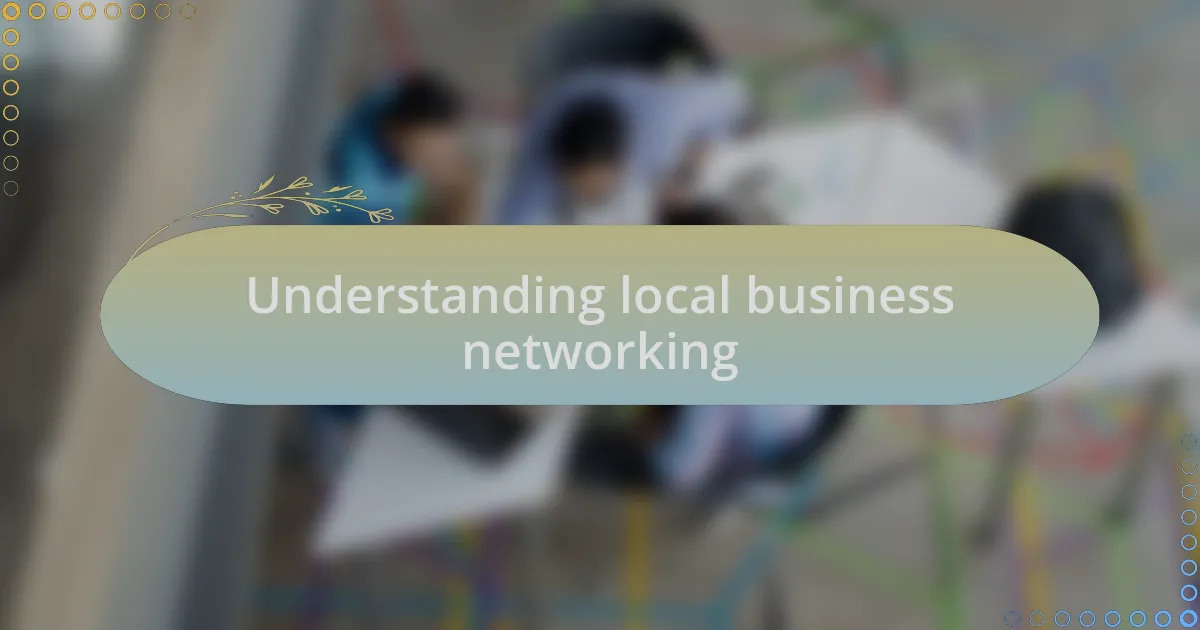
Understanding local business networking
Local business networking can be a game-changer for entrepreneurs. I remember my first networking event; I walked in with a mix of excitement and anxiety. Connecting with others who share your ambition and challenges can be incredibly validating and motivating.
One of the most important aspects of local networking is trust building. Over time, I’ve learned that the strongest relationships often lead to referrals and collaborations. It’s amazing how simply engaging in genuine conversations can lead to unexpected opportunities—have you ever found a business partner or client just by sharing a meal or a cup of coffee?
Additionally, leveraging local insights can set your business apart. When I tapped into community events and local gatherings, I gained invaluable information about consumer trends and preferences that you simply can’t find online. It’s like unlocking a treasure chest of knowledge that can guide your business decisions and strategies. How often do we take for granted the resources right in our neighborhood?
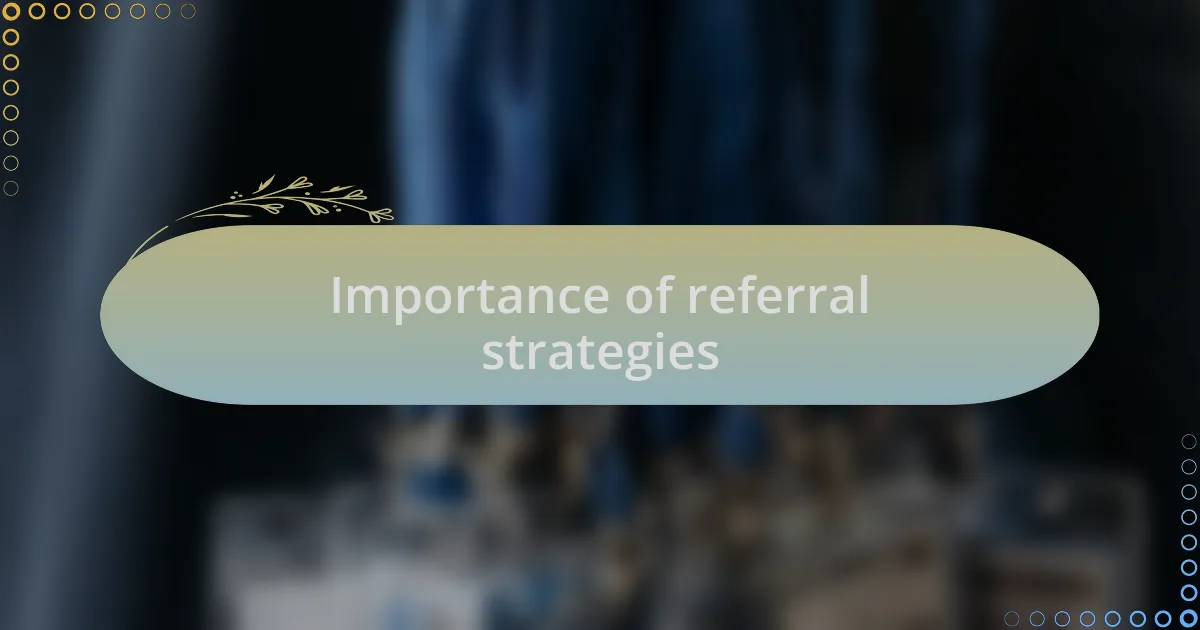
Importance of referral strategies
Building a solid referral strategy can significantly boost your business prospects. I once met a local florist who shared that most of her clients came from word-of-mouth referrals. Her enthusiasm when recounting how a simple recommendation transformed her business was infectious. Can you imagine the impact of just one satisfied customer spreading the word about your services?
Moreover, having a reliable referral network can enhance your credibility in the community. Each time someone refers you to a potential client, it’s like receiving an unspoken endorsement. I recall a time when a local accountant sent a client my way; the trust that came with that referral led to a lasting partnership. Isn’t it rewarding to know that others believe in your work enough to recommend you?
In my experience, a well-structured referral strategy cultivates lasting relationships. It creates a community of mutual support where everyone benefits. Wouldn’t it be great if we could all thrive together through shared connections? By nurturing these relationships, I’ve often found that collaboration can yield results far beyond solo efforts.
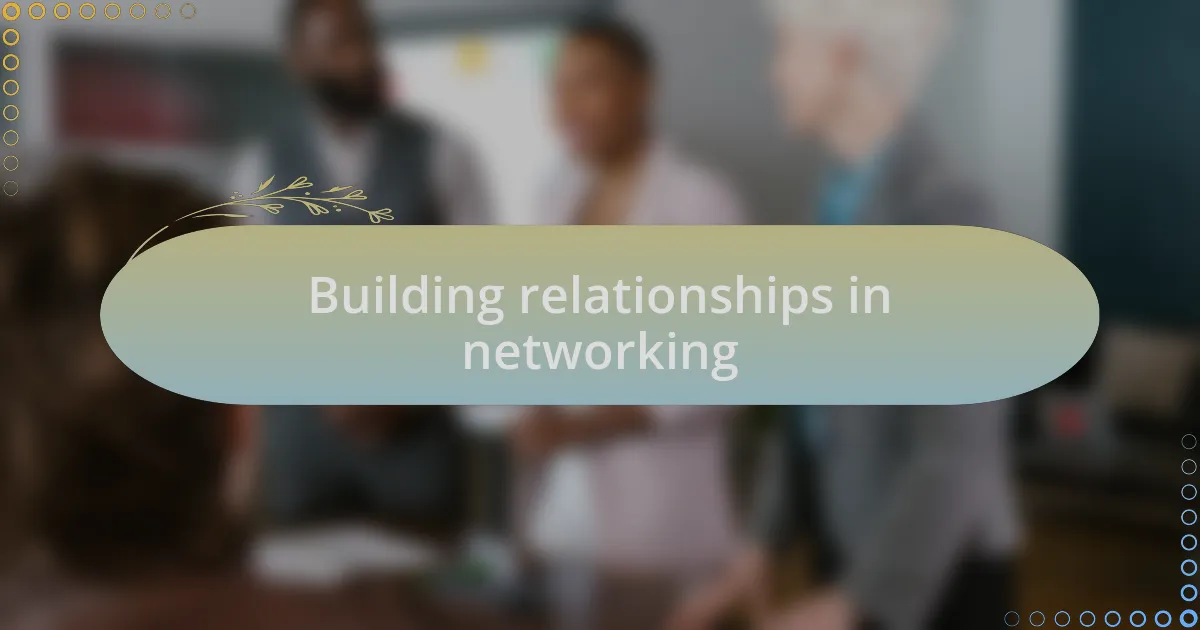
Building relationships in networking
One of the most fulfilling aspects of networking is watching relationships grow over time. I remember attending a monthly meet-up where I initially knew no one. Fast forward a few events later, and I found myself genuinely cheering on a fellow entrepreneur’s success. Building these relationships isn’t just about who you know; it’s about developing a support system that feels like family. Have you ever felt that rush when you realize you’re not alone in your journey?
Finding common ground is key to stronger connections in networking. I often share my struggles and achievements openly, inviting others to do the same. At one gathering, a simple conversation about balancing work and family life led to a collaboration that benefited both of us. Isn’t interesting how shared experiences can break down barriers and create meaningful partnerships?
Spending time cultivating relationships in networking isn’t just beneficial; it’s essential. The connections I’ve formed provide not just referrals, but genuine friendships. After all, wouldn’t you rather lean on someone you trust when making crucial business decisions? Mutual support is the foundation of sustainable success and leads to countless opportunities for growth.

Identifying potential referral sources
Identifying potential referral sources starts with understanding your local community. I often walk through my neighborhood and pay attention to the businesses around me. One day, I noticed a small bakery next to a yoga studio. What a perfect match! If the bakery offered healthy treats, they could easily refer customers to the yoga studio. Where do you see untapped connections in your area?
Networking events are another goldmine for spotting potential referrers. I recall meeting a graphic designer at a local chamber of commerce meeting. We quickly discovered how our services complemented each other. She needed a reliable printer for her projects, and I wanted to connect with local businesses to expand my reach. Don’t you find it fascinating how a casual conversation can spark mutual opportunities?
Lastly, consider tapping into existing relationships. In my experience, some of my most valuable referral sources were former colleagues or clients. One of my past clients, who was thrilled with my service, became my biggest advocate, introducing me to new clients without me even asking. Isn’t it incredible how past positive experiences can turn into future referrals? Make a list of your connections; you might be surprised by how many potential sources are right at your fingertips.
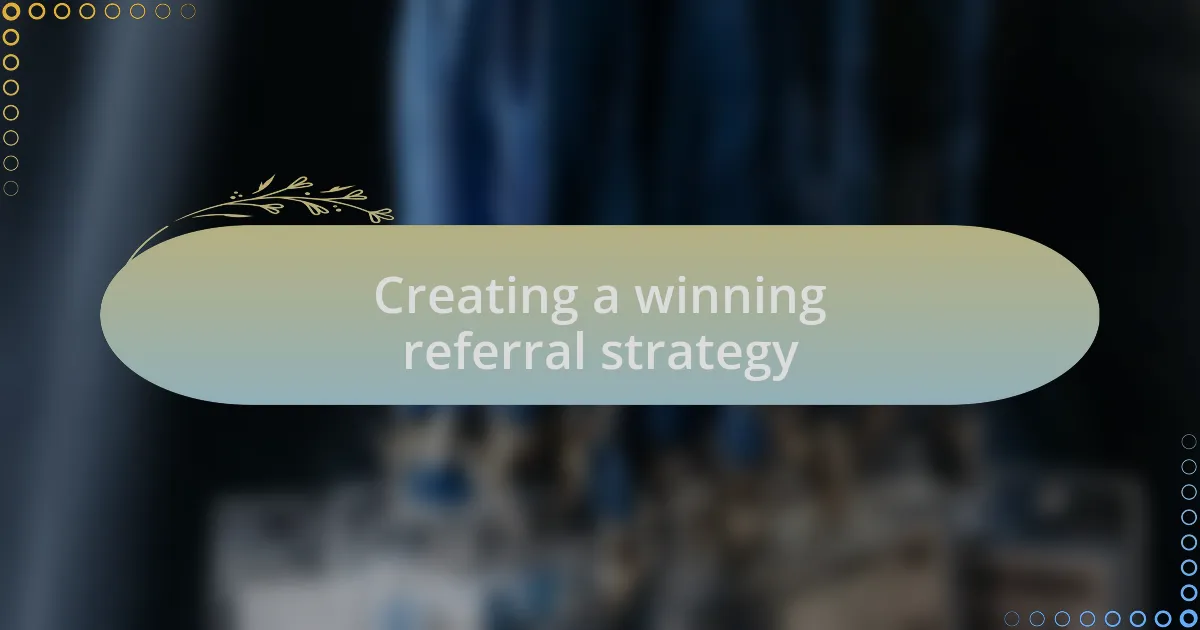
Creating a winning referral strategy
Creating a winning referral strategy involves establishing clear communication with your referral sources. For example, I once scheduled regular coffee meetings with a few key partners to discuss how we could better support each other. This open dialogue not only strengthened our relationships but also lit the spark for collaborative marketing efforts. Have you ever thought about how often you touch base with those in your network?
Another key aspect is to provide value before asking for referrals. I make it a point to recognize the contributions of my referrers by sending handwritten thank-you notes or small tokens of appreciation after they introduce me to potential clients. This simple gesture not only shows gratitude but also fosters goodwill, encouraging them to keep referring others. Isn’t it amazing how a little thoughtfulness can go such a long way?
Moreover, I find it’s crucial to articulate what you need from your referral partners. During a recent networking event, I openly shared my target clientele and the types of connections I was hoping to make. To my surprise, several attendees stepped up, eager to help. Have you ever considered that being specific about your needs can actually entice others to assist you?
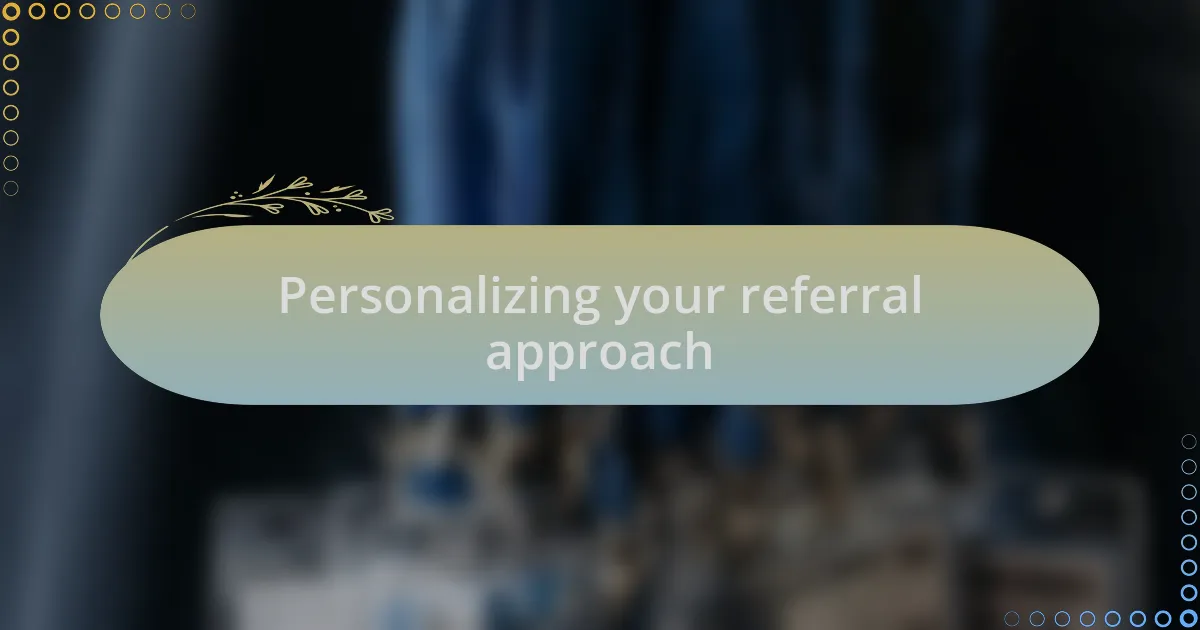
Personalizing your referral approach
When personalizing your referral approach, I’ve discovered that incorporating elements that resonate with the individual you’re connecting with makes all the difference. For instance, I once tailored my request based on a referral partner’s interests, sharing how their specific expertise could tremendously help a mutual contact. It was like watching a light bulb go off—suddenly, they were fully engaged and eager to contribute.
Another important facet is the power of storytelling in your interactions. I remember sharing a relatable experience during a casual meetup, where I faced a common challenge that my referral partner had recently solved. This created a unique bond and made the conversation flow naturally towards how we could support each other. Don’t you think that when you connect personally, it prompts a stronger desire to help?
Finally, consistency in communication is key to personalizing your approach. I make it a habit to check in with my referral partners regularly—not just when I need something. Just the other day, I sent a quick message to a partner, sharing a resource that I thought might be beneficial to them. It’s these small, consistent acts that lay the groundwork for a referral relationship built on mutual trust and respect. How often do you reach out, just to touch base?
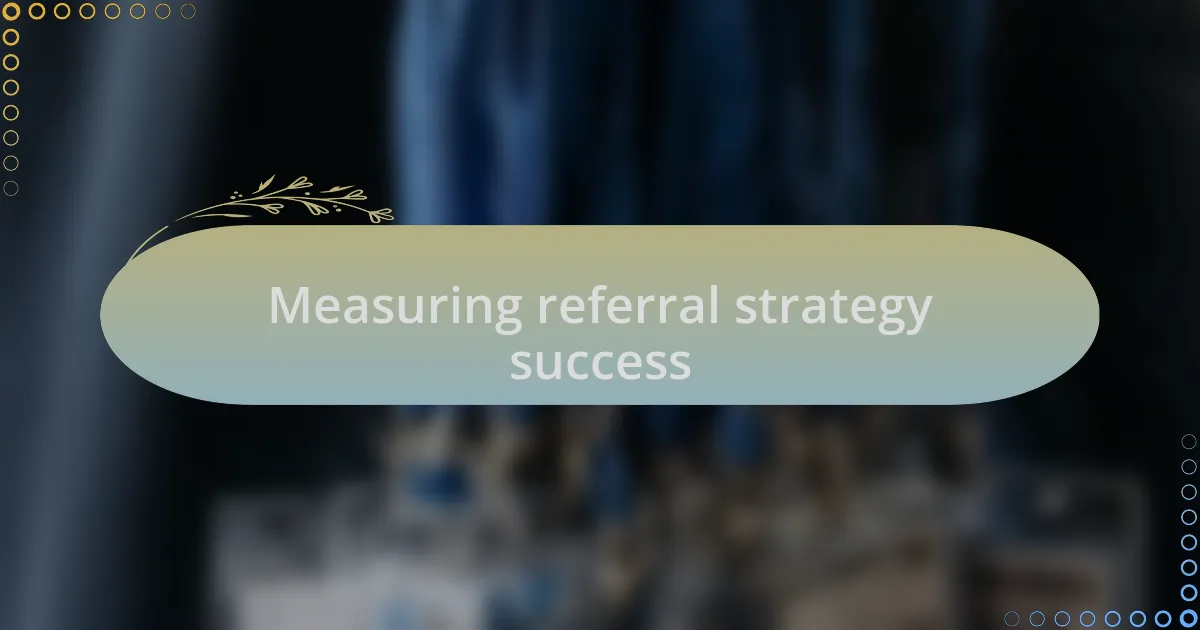
Measuring referral strategy success
To truly assess the success of my referral strategy, I often look at the number of leads generated from those referrals. For example, last quarter, I tracked a particular partnership that consistently yielded quality leads—five referrals turned into three new clients. When I saw that direct correlation, it motivated me to strengthen that connection even further.
Another critical measure is the conversion rate of referrals into actual business. Reflecting on my experiences, I once noted that a specific group of referral partners had a much higher conversion rate, significantly impacting my growth. It made me realize that fostering relationships with the right people can lead to tangible results—could there be a more powerful incentive for your networking efforts?
I also keep an eye on the feedback I receive from both referred clients and my partners. I remember a situation where a client praised my referral partner for their exemplary service, which reinforced the value of that connection. It’s those moments of positive reinforcement that not only validate my strategy but also encourage me to refine it continuously. How often do you seek feedback to gauge how well your referral efforts are truly landing?